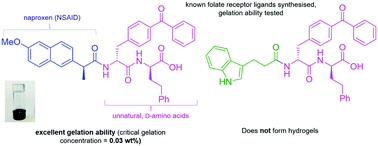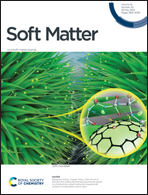An injectable, naproxen-conjugated, supramolecular hydrogel with ultra-low critical gelation concentration—prepared from a known folate receptor ligand†
Abstract
Short peptides capped on the N-terminus with aromatic groups are often able to form supramolecular hydrogels—self-assembled networks of fibrils able to trap water molecules. Typically, these hydrogelators can form stiff gels at concentrations of 0.1 to 1.0 wt%—i.e. they consist of mainly water. The properties of these soft materials mimic those of the extracellular matrix (ECM) of biological tissue and therefore they have found many biomedical uses in tissue engineering, wound healing, drug delivery, biosensing and bioprinting applications. In drug delivery strategies related to cancer therapy, injectable hydrogels can serve as a depot formulation, where a sustained release of the chemotherapeutic from near the tumour site allows reduced doses and, therefore, decreased side effects. To further target cancer cells, folic acid-conjugated hydrogels and nanostructures are often sought, to exploit the overexpression of folate receptors on cancer cells—an approach which can allow the selective cellular uptake of an encapsulated drug. In this present study, two known dipeptide folate receptor ligands (1 and 2) recently identified from a screen of a DNA-encoded compound library, were synthesised and investigated for their hydrogelation ability and cytotoxicity. Compound 1, containing a naproxen capping group, rapidly forms hydrogels at concentrations as low as 0.03 wt%—one of the lowest critical gelation concentrations (CGCs) known for a supramolecular hydrogelator. In contrast, compound 2, which contains a 3-indolepropionic acid capping group, was unable to form hydrogels under a range of conditions and concentrations, instead forming nanospheres with diameters of 0.5 μm. Hydrogels of 1 were characterised by STEM microscopy, rheology, fluorescence spectroscopy and circular dichroism. Both compounds 1 and 2 had no impact on the proliferation of kerotinocytes (HaCaT cells) at concentrations up to 100 μM. Compound 1, containing the NSAID, was tested for anti-inflammatory activity in a human cyclooxygenase-1/2 model. The rate of the release of model drug compounds from within hydrogels of 1 was also investigated.



 Please wait while we load your content...
Please wait while we load your content...